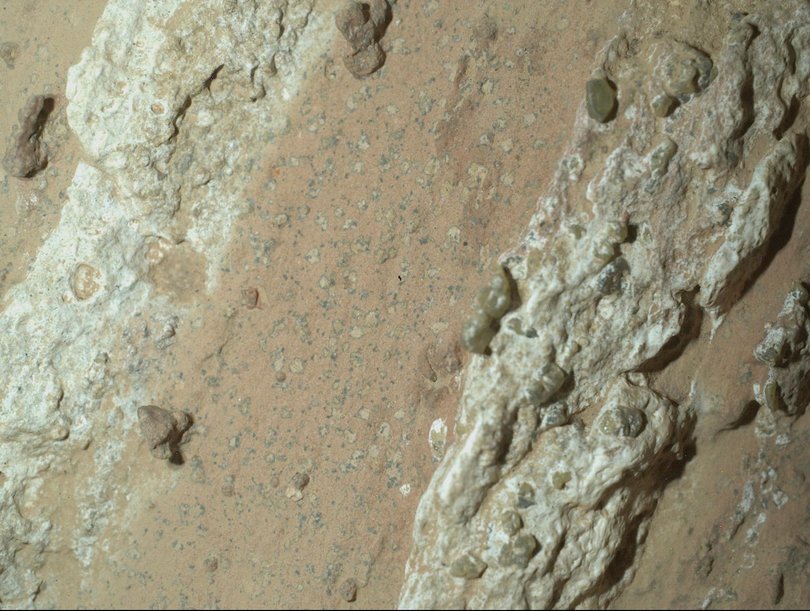NASA discovers ‘clearest sign of life that we’ve ever found on Mars’

Rolling across the rugged, rusty red terrain on Mars, NASA’s Perseverance rover came upon some rocks with peculiar green, blue, black and white dots. After detailed image analysis, scientists have come to a potentially encouraging conclusion: If those speckled rocks were formed like they are on Earth, they might be evidence of past life on the dusty planet.
The rocks “very well could be the clearest sign of life that we’ve ever found on Mars, which is incredibly exciting,” acting NASA administrator Sean P. Duffy said in a news conference Wednesday. The findings were published in the journal Nature on Wednesday.
The rocks, or mudstones, are composed of finely packed sediment and covered in specks resembling poppy seeds and leopard spots. The colorful features, the study found, are minerals that - on Earth - have traditionally been created from microbial activity.
Sign up to The Nightly's newsletters.
Get the first look at the digital newspaper, curated daily stories and breaking headlines delivered to your inbox.
By continuing you agree to our Terms and Privacy Policy.The research team would need to investigate pieces of the rocks in person to confirm if a Martian microbe was behind the unusual patterns. That’s far easier said than done. But Joel Hurowitz, lead author of the study, called the rocks “probably the most astrobiologically exciting” samples identified by the Perseverance rover since it landed on Mars in 2021.
“The sample contains what we believe to be a potential biosignature,” a feature that could have a biological origin, he said. “I don’t think we can say that about any of the other samples that we collected” on the rover’s journey.
The rover has been exploring an area known as the Jezero Crater, which scientists say was once a lake bed with aspects that made it conducive to life. The rocks were found inside Neretva Vallis, an ancient river valley that shuttled water to the crater billions of years ago.
“The thing I find most exciting about this sample is that it contains features large enough to be seen with the naked eye that could be examined to test for past life,” said Michael Tice, a study co-author and member of the Mars 2020 Perseverance science team searching for signs of life. “That’s surprisingly rare when you are studying evidence for ancient microscopic life.”

One idea of how the rocks may have accumulated there, Associate Professor Hurowitz said, is that the river valley may have been temporarily dammed up, perhaps by a landslide. He said the ancient scene may have looked similar to the Mississippi River today, with mud settling to the bottom of turbid brown water.
As sediment accumulated, he recounted, the muddy rocks seemed to have brought in iron, phosphorus and sulphur as well as organic matter. The organic matter is exciting in itself, Hurowitz said, because the carbon-based molecules are the building blocks of life. It could have come from a life form long ago, or it could have served as food for other living organisms. Or it could be tied to a nonliving source, such as a meteorite.
“We don’t know where that matter came from, but we detect it in the mud,” Assoc-Prof Hurowitz said. “This is really the first compelling signal of organic matter that we’ve had since we landed in Jezero Crater.”
But the colorful speckles on the rocks pose an even more alluring mystery. These features are two well-known minerals made of iron, phosphorus and sulfur. One called vivianite - also sometimes referred to as corpse crystals - forms during the decay of organic material and is blue-green.
The other, called greigite, shows up as a dull brown. But when these two minerals are found together in sediments on Earth, Hurowitz said, it’s usually a result of microbial metabolisms.
“Microbes will eat the organic matter and react it with the mud, and the by-product of that reaction is these minerals,” Assoc-Prof Hurowitz said. “That’s kind of why we’re as excited as we are about this.”
The authors acknowledge that these minerals could have formed without microbes - with the involvement of heat, for instance. But the new study determined the Martian rocks don’t appear to have been heated.
“The available evidence collected by the rover seems to point more strongly towards the possibility of microbial activity,” Assoc-Prof Hurowitz said.
The involvement of microbes is plausible, said Nicolas Dauphas, a planetary scientist who was not involved in the research. But to be more certain would require direct measurements or detailed mineralogical and chemical analyses - and that would mean bringing the samples back to Earth.
“These rocks are prime targets in the search for ancient life on Mars,” said Professor Dauphas, from the University of Hong Kong, in an email. “Only (a) Mars sample return can answer the billion-dollar question: ‘Was there ever life on Mars?’”
But that journey between the planets is uncertain. Last year, NASA put its Mars Sample Return mission on a bare-bones budget. In January, the agency said it will entertain two potential approaches to grab the samples.
One is a previously used “sky crane” technique demonstrated by NASA’s Jet Propulsion Laboratory, and the other would be a less clear option from the commercial sector. NASA is expected to confirm which strategy to pursue in the second half of next year.
But President Donald Trump’s fiscal 2026 budget request, if approved by Congress, ends the Mars Sample Return mission - deeming it financially unsustainable. In Wednesday’s news conference, Mr Duffy said the administration is still committed to human exploration and, therefore, scientific research like this. He said the goal is to find better and faster ways to bring back the samples.
“What we’re going to do is look at our budgets, we’re going to look at our timing and how do we spend money better and what technology do we have to get samples back more quickly,” Mr Duffy said. “So that’s a current analysis that’s happening right now.”
There are ways to remotely learn more about how these speckled rocks were made, Assoc-Prof Hurowitz said. Scientists could try to mimic the Martian conditions in labs on Earth and re-create the processes that formed the minerals, which could help them understand if microbes were required.
But the most fruitful - and perhaps the only really definitive - investigation would happen by analyzing the rock directly, the authors agreed. And if the minerals were created by microbes, the search for life on Mars could become a lot more interesting.
“If microorganisms once existed on Mars, there is a possibility that their descendants could still be there,” Professor Tice said, “just living in different environments.”
© 2025 , The Washington Post
